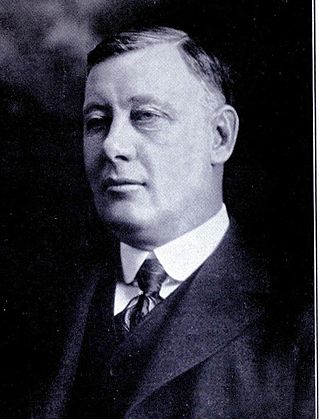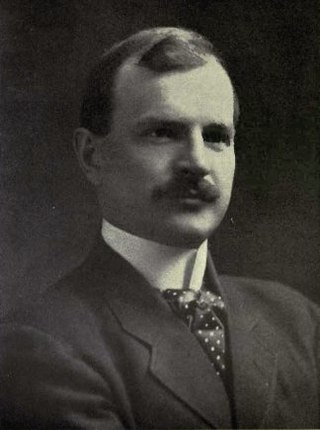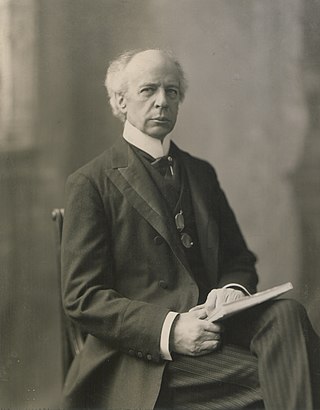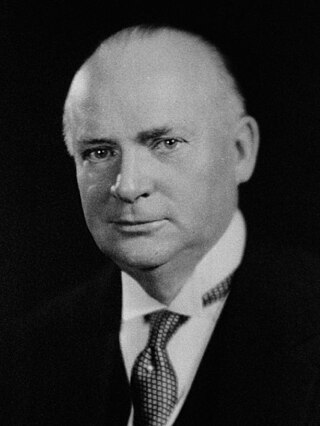
Sir Robert Laird Borden was a Canadian lawyer and politician who served as the eighth prime minister of Canada from 1911 to 1920. He is best known for his leadership of Canada during World War I.

The Postmaster General of Canada was the Canadian cabinet minister responsible for the Post Office Department. In 1851, management of the post office was transferred from Britain to the provincial governments of the Province of Canada, New Brunswick, Newfoundland, Nova Scotia and Prince Edward Island. The position of Postmaster General was established in each province. With Canadian Confederation in 1867, a single position was created replacing this post in all of the above provinces except Newfoundland; this position was abolished in 1981 when the post office was transformed from a government department into a crown corporation. Since 1981 Canada Post has been led by a President and CEO. From 1900 until 1909 the Postmaster General was also responsible for the Department of Labour. It now reports to the Minister of Public Services and Procurement.

Sir George Halsey Perley was an American-born Canadian politician and diplomat.

Sir James Albert Manning Aikins was a politician in Manitoba, Canada. He was the leader of the Manitoba Conservative Party in the provincial election of 1915, and later served as the province's ninth Lieutenant Governor.

Albert Sévigny, was a Canadian politician, and a judge.

Charles Colquhoun Ballantyne, was a Canadian politician.

Sir Albert Edward Kemp was a Canadian businessman and politician. Kemp was a Canadian Minister of Militia and Defence and Minister of Overseas Military Forces during World War I. A Conservative and Unionist, Kemp was elected five times to the House of Commons of Canada as the Member of Parliament for electoral district of Toronto East. He was appointed to the Senate of Canada by Prime Minister Arthur Meighen in 1921.

Esioff-Léon Patenaude,, often called E.L. Patenaude, was a Canadian statesman who served as the 17th Lieutenant Governor of Quebec. Born in Saint-Isidore, Quebec, in 1875, he studied law at the University of Montreal and was called to the Quebec Bar in 1899. He established a successful law practice, was soon drawn to politics, and served as a chief organizer for the Conservative Party of Canada in Montreal.

The 12th Canadian Parliament was in session from 15 November 1911 until 6 October 1917. The membership was set by the 1911 federal election on 21 September 1911, and it changed only somewhat due to resignations and by-elections until it was dissolved prior to the 1917 election. At 5 years, 10 months and 22 days, it was the longest parliament in Canadian history. The parliament was extended beyond the normal limit of five years by the British North America Act, 1916 as a result of World War I.

Pierre-Édouard Blondin, was a Canadian politician.

The Thirteenth Canadian Ministry was the second cabinet chaired by Prime Minister Arthur Meighen. It governed Canada from 29 June 1926 to 25 September 1926, including only the last three months of the 15th Canadian Parliament, all cabinet ministers were acting cabinet ministers as Meighen hadn't been given the confidence of the house, and any cabinet ministers appointed by him would have had to resign their seats and run for re-election. The government was formed by the old Conservative Party of Canada. Meighen was also Prime Minister in the Eleventh Canadian Ministry.

The Eleventh Canadian Ministry was the first cabinet chaired by Prime Minister Arthur Meighen. It governed Canada from 10 July 1920 to 29 December 1921, including only the last year of the 13th Canadian Parliament. The government was formed by the National Liberal and Conservative Party. Meighen was also Prime Minister in the Thirteenth Canadian Ministry.

The Tenth Canadian Ministry was the second cabinet chaired by Prime Minister Sir Robert Borden. It governed Canada from 12 October 1917 to 10 July 1920, including most of the 13th Canadian Parliament. The government was formed by the Unionists, a war-time coalition between the old Conservative Party of Canada and some members of the Liberal Party of Canada. Borden was also Prime Minister in the Ninth Canadian Ministry, but formed a coalition ministry for the 1917 Canadian federal election.

The Eighth Canadian Ministry was the cabinet chaired by Prime Minister Sir Wilfrid Laurier. It governed Canada from 11 July 1896 to 5 October 1911, including all of the 8th, 9th, 10th, and 11th Canadian Parliaments. The government was formed by the Liberal Party of Canada.

Arthur Meighen was a Canadian lawyer and politician who served as the ninth prime minister of Canada from 1920 to 1921 and from June to September 1926. He led the Conservative Party from 1920 to 1926 and from 1941 to 1942.

A Conservative leadership convention was held on October 12, 1927 at the Winnipeg Amphitheatre in Winnipeg, Manitoba. The convention was held to choose a new leader of the Conservative Party to choose a successor to former Prime Minister of Canada Arthur Meighen who had led the party since 1920. This was the first time the Conservatives used a leadership convention to choose a leader. Previous leaders had been chosen by the party's caucus, the previous leader, or by the Governor General of Canada designating an individual to form a government after his predecessor's death or resignation.
The Minister of Overseas Military Forces was established in November 1916 to administer Canadian forces in the United Kingdom during World War I, and abolished in 1920. The position was largely to act as the communications channel between the Department of Militia and Defence, the British War Office, and the Canadian Corps.

This article is the Electoral history of Robert Borden, the eighth Prime Minister of Canada (1911-1920).














